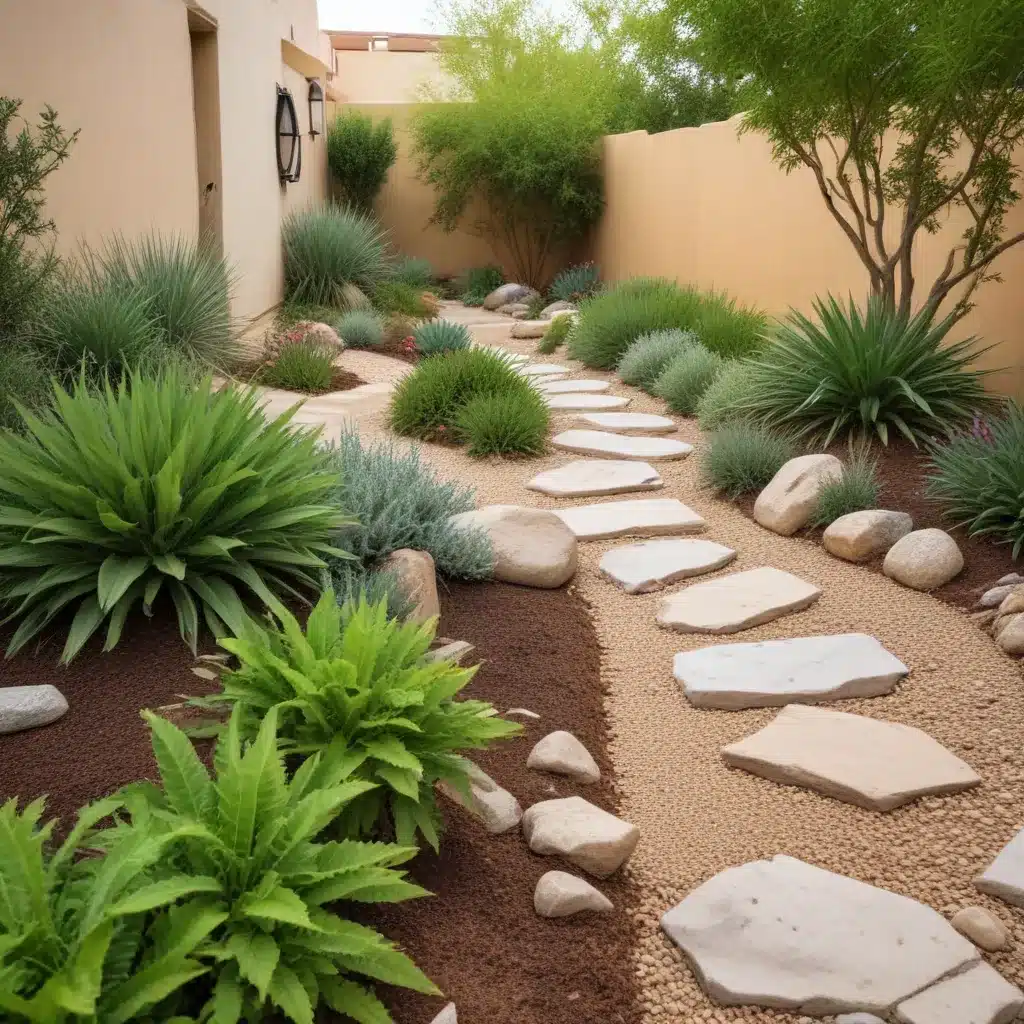
Embracing Arid Landscapes: The Beauty of Drought-Tolerant Design
As a seasoned construction professional and interior designer, I’ve witnessed the growing need for water-wise landscaping solutions in our ever-changing climate. In this comprehensive article, we’ll explore the strategies and techniques that can transform your outdoor space into a lush, drought-resistant oasis, without sacrificing aesthetic appeal.
In many regions, water scarcity has become an increasingly pressing concern, making it essential to rethink our approach to landscape design. By embracing drought-tolerant plants, efficient irrigation systems, and sustainable hardscaping, we can create stunning, water-conserving environments that not only enhance the beauty of your property but also contribute to the long-term health of our planet.
Selecting Drought-Resistant Plants: The Foundation of a Resilient Landscape
The key to a successful drought-tolerant landscape lies in the careful selection of plants that thrive in arid conditions. When choosing your plant palette, look for species that are native to your local climate, as they are inherently better adapted to the region’s environmental factors, such as soil type, sunlight exposure, and seasonal rainfall patterns.
Some characteristics to seek out in drought-resistant plants include:
- Deep root systems: These plants are able to access water deep within the soil, making them more resilient during dry spells.
- Succulent or fleshy leaves: Plants with these features are better equipped to store water and minimize moisture loss.
- Silvery or waxy foliage: This type of foliage reflects sunlight, reducing the plant’s water needs.
By incorporating a diverse selection of drought-tolerant plants, such as baccharis, ceanothus, and erigeron, you can create a visually striking and environmentally responsible landscape.
Efficient Irrigation: Maximizing Water Conservation
Efficient irrigation is a crucial component of any water-wise landscape design. Traditional sprinkler systems can be incredibly wasteful, with much of the water evaporating or running off before it reaches the plant’s roots. Instead, consider investing in a drip irrigation system, which delivers water directly to the soil around each plant, minimizing water loss and promoting deep root growth.
Integrating an automated irrigation controller can further enhance water efficiency by adjusting watering schedules based on environmental factors, such as rainfall, temperature, and soil moisture levels. This smart technology ensures that your plants receive the precise amount of water they need, without over-watering or wasting precious resources.
Harnessing Rainwater and Greywater: Creative Water Collection Strategies
In addition to efficient irrigation, incorporating creative water collection and reuse strategies can significantly reduce your landscape’s water consumption. Rain barrels and cisterns are excellent options for capturing and storing rainwater, which can then be used to irrigate your plants, wash cars, or even top up water features.
Another innovative approach is the use of greywater systems, which repurpose household wastewater from sinks, showers, and washing machines to irrigate your landscape. By diverting this “greywater” away from the sewer system, you can dramatically decrease your reliance on municipal water supplies.
The Power of Mulch and Ground Cover: Soil Moisture Management
Mulch and ground cover play a vital role in maintaining soil moisture and reducing water evaporation in a drought-resistant landscape. Organic mulches, such as bark chips, straw, or compost, help insulate the soil, regulate temperature, and suppress weed growth, all of which contribute to water conservation.
Ground covers, on the other hand, create a living carpet that shades the soil and prevents moisture loss through evaporation. By strategically incorporating low-growing, drought-tolerant plants like erigeron or mimulus, you can create a lush, water-efficient groundcover that complements your larger landscape design.
Hardscaping for Water-Wise Environments
While plants are the foundation of a drought-resistant landscape, thoughtful hardscaping can also play a crucial role in water conservation. Consider incorporating permeable paving materials, such as porous concrete or pavers, which allow rainwater to infiltrate the soil rather than running off and potentially contributing to erosion or flooding.
Another water-wise hardscaping approach is the use of dry streambed features, which mimic the look and function of natural watercourses. These decorative elements not only enhance the aesthetic appeal of your landscape but also help to direct and distribute rainwater, reducing the need for supplemental irrigation.
Maintenance and Seasonal Adjustments: Ensuring Long-Term Success
Maintaining a drought-resistant landscape requires a mindful, seasonally-adjusted approach. In the spring, focus on pruning, cleanup, and adjusting irrigation schedules to accommodate new growth. During the hot summer months, be vigilant about monitoring soil moisture and adjusting watering as needed to keep your plants healthy and thriving.
In the fall, apply a balanced fertilizer to help your plants prepare for the winter, and protect any tender species with mulch or temporary coverings. Regular inspections throughout the year will help you identify any issues early on, allowing you to address them before they become problematic.
Conclusion: Embracing a Sustainable Future
Designing drought-resistant landscapes is not only a practical solution to water scarcity but also an opportunity to create visually stunning outdoor spaces that contribute to the health of our environment. By incorporating drought-tolerant plants, efficient irrigation systems, water collection strategies, and sustainable hardscaping, you can transform your property into a lush, water-wise oasis that thrives even in the driest of conditions.
As a seasoned construction professional and interior designer, I’m proud to share these insights with you, empowering you to create beautiful, sustainable landscapes that conserve our precious water resources. Remember, each step you take towards a water-wise outdoor space is an investment in a greener, more resilient future. Let’s work together to design the drought-resistant oasis of your dreams.
For more information on our water-wise landscaping services, please visit LocalBuilderLondon.co.uk.


